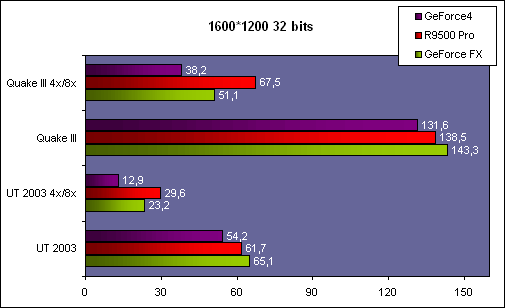I was looking at that issue, and it looks like NV30 is some 20% behind ATI in that regard, which is not like the NVidia we knew since the GF3.
From the info here (1600x1200 to keep GPU clock scaling linear):
http://firingsquad.gamers.com/hardware/ati_radeon_9500_pro_overclock/default.asp
The 256-bit bus give the 9700 an advantage over the 9500 PRO of:
- 41% in Q3 with FSAA/AF
- 29% in UT2003 w/o FSAA/AF
- 15% in UT2003 with FSAA/AF
From Anand:
- 37% in SS2 w/o FSAA/AF
- 21% in SS2 with FSAA/AF (1024x768)
From Anand's review, GFFX Ultra has an advantage over the 9700 (non PRO, quality AF) of:
- 13% in Q3 with FSAA/AF
- 42% in UT2003 w/o FSAA/AF
- 19% in UT2003 with FSAA/AF
- 27% in SS2 w/o FSAA/AF
- 15% in SS2 with FSAA/AF (1024x768)
Do some math, and you get a
9500 PRO at 500/500 (85% overclock) having an advantage over a GFFX Ultra of:
-
16% in Q3 with FSAA/AF
-
1% in UT2003 w/o FSAA/AF
-
35% in UT2003 with FSAA/AF
-
18% in SS2 w/o FSAA/AF
-
21% in SS2 with FSAA/AF (1024x768)
The same advantage would apply to a GFFX clocked at 270/270 (obviously).
Now, I know I used multiple sources, and there are problems with linearity (although the GFFX and GFFX Ultra scale almost exactly with clock speed for these tests), etc.
Still, this gives you a big reason why everyone is disappointed with the performance of the GeforceFX, on top of the ordered grid AA, noisy cooler, size, heat, price...

